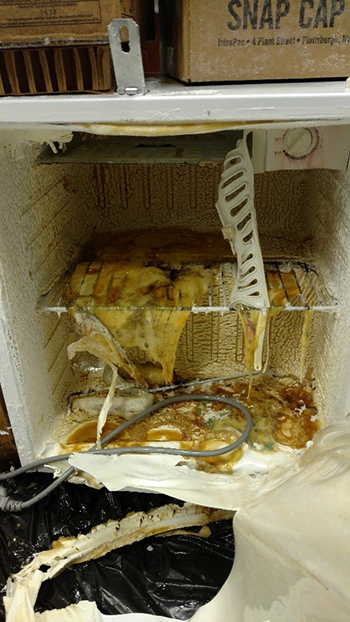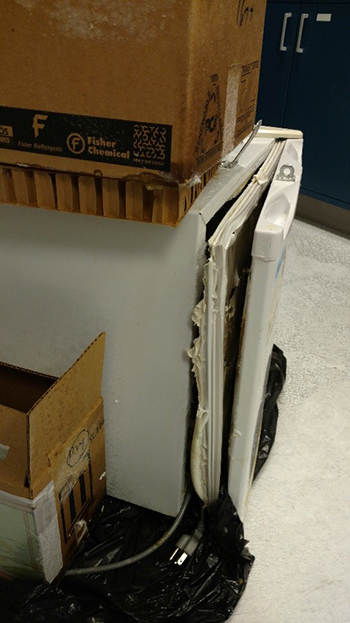Managing Polymerizable, Self-Heating and Other Reactive Chemicals
Workers in a campus research lab recently arrived at work only to discover an odorous, viscous liquid seeping from a small, locked, below-counter freezer unit. The freezer was very seldomly accessed and no one in the lab could fully account for its contents.
Upon responding to investigate, Environmental Health and Safety discovered that a significant reaction had occurred within the freezer over the previous weekend as clearly illustrated in the following pictures. Please click on pictures for a larger image.
  
While lab personnel could not produce a current chemical inventory for the freezer, they were able to report that the freezer was used to stored polyermizable chemicals used in conjunction with the laboratory’s research efforts. No one in the lab was certain when the last time the freezer unit was accessed or inspected.
Based on the remaining contents in the freezer, EHS believes that a monomer self-polymerized due to insufficient inhibitor concentration allowing for the formation of free radicals possibly coupled with the failure of the freezer compressor (which allowed the freezer unit warm well above that of the ambient temperature of the laboratory). The ensuing chemical reaction resulted in the plastic components of the freezer and plastic contents melting.
It appears at this time that the reaction was self-limiting since the freezer was locked by means of hasp and padlock. This limited the availability of oxygen necessary to support combustion. EHS regards the incident as a near-miss as it appears the reaction approached a temperature which could have sustained combustion. The incident certainly reinforces the need for laboratories to be diligent and aggressive in managing polymerizable, self-heating or other reactive chemicals. EHS recommends that laboratories:
• Maintain an inventory of polymerizable, self-heating or other reactive chemicals.
• Review Safety Data Sheets or other safety profiles in order to be familiarized with any special storage or handling limitations or requirements.
• Date containers when received and when opened.
• Use the materials according to the directions of the manufacturer. Follow all applicable safety guidance including those specified by University program or policy.
• Inspect containers on a regular basis. Immediately refer to EHS for disposal any container showing signs of damage including cracking or crazing or damage to inner seals.
• For those materials requiring chemical inhibitors to prevent self-polymerization, discard in a timely manner when it is apparent there is no longer an immediate need for the material. Replace with fresh material when the need re-arises. Self-polymerizing materials cannot be safety stored for an extended period of time without checking and maintaining an appropriate concentration of inhibitor.
• When using a mechanical refrigeration for storage, ensure that the refrigerator/freezer unit is rated for the materials to be stored within. Also, keep in mind that most smaller refrigerator/freezer units have an effect life span of 5 to 10-years. Make it a responsibility for someone in the lab to inspect the refrigerator/freezer and its contents on a regular basis.
Please contact our laboratory safety staff or our office at ehs@iupui.edu or 274-2005 if you need additional guidance on the storage and use of reactive materials. |